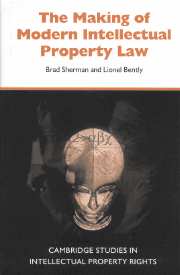Book contents
- Frontmatter
- Contents
- Acknowledgments
- List of abbreviations
- Table of statutes and bills
- Table of cases
- Introduction
- Part 1 Towards a property in intangibles
- Part 2 The emergence of modern intellectual property law
- Part 3 Towards an intellectual property law
- Part 4 Transformations in intellectual property law
- Bibliography
- Index
3 - Designing the law
Published online by Cambridge University Press: 29 May 2025
- Frontmatter
- Contents
- Acknowledgments
- List of abbreviations
- Table of statutes and bills
- Table of cases
- Introduction
- Part 1 Towards a property in intangibles
- Part 2 The emergence of modern intellectual property law
- Part 3 Towards an intellectual property law
- Part 4 Transformations in intellectual property law
- Bibliography
- Index
Summary
The first statute to deal explicitly with the legal protection of designs was the Calico Printers’ Act of 1787. This Statute, which was passed not long after the end of the literary property debate, conferred two months’ protection on ‘every person who shall invent, design and print … any new and original pattern … for printing linens, cottons, calicos or muslins’. The Act, which was championed by William Kilburn on behalf of the London calico printers, was modelled on the existing statutes giving protection to authors and engravers. Although passed as a temporary measure, the Act was renewed in 1789 and then again in 1794 when the length of protection was extended to three months and the provisions were given permanent effect.
While this legislation served its ends fairly well, it became apparent early in the nineteenth century that there was an urgent need to improve the state of British design. Britain was able to produce manufactured goods more cheaply and in greater quantity than many of its competitors, but when these goods were compared with those produced by other trading nations, particularly France, it was thought that their sale suffered from their inferior aesthetic quality. In order to improve this situation, a number of changes were proposed. These included the establishment of design schools to improve the skills of British designers and the opening of a museum (later called the Victoria and Albert Museum) where, with a view to improving standards of taste, ‘good designs’ were to be exhibited to the public. Attention was also given to improving the legal regime which provided property protection for designs. To this end, the 1787 Calico Printers’ Act was repealed and replaced by the two new acts.
The first of these, the Copyright of Designs Act, which was passed on 4 June 1839, widened the category of subject matter which was protected under the 1787 Calico Printers’ Act from its initial limitation to certain vegetable fabrics (such as cotton, linen, calico and muslin) to include animal fabrics (wool, silk or hair and mixtures thereof). It also extended the jurisdiction of the Act to include Ireland. The protection provided by the 1839 Act, which arose automatically on publication of the design was, like the Calico Printers’ Act of 1787, limited to three months.
Information
- Type
- Chapter
- Information
- The Making of Modern Intellectual Property LawThe British Experience, 1760-1911, pp. 63 - 76Publisher: Cambridge University PressPrint publication year: 1999
